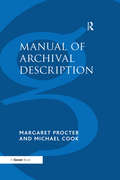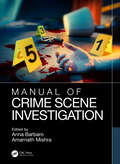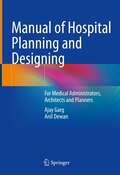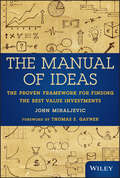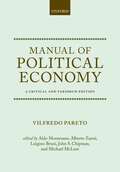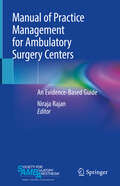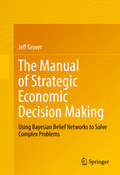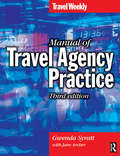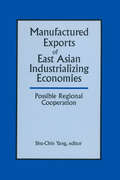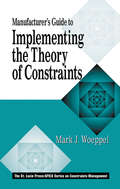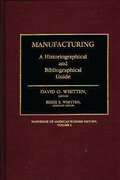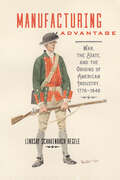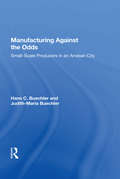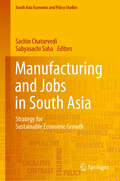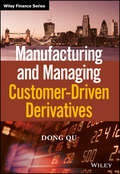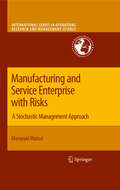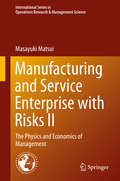- Table View
- List View
Manual of Archival Description
by Michael Cook Margaret Procter’MAD3’ is the third and latest edition of the influential Manual of Archival Description, revised to take account of a decade of developments in national and international descriptive practice. Many improvements have been made as a result of wide consultation with archive professionals. The Manual remains the only comprehensive British guide to the theory and practice of listing archives held in any format, from letters, photographs and maps to electronic multimedia. New features of this edition include: ¢ additional information on national and international standards which have appeared since the last edition, including data elements mapped to the General International Standard Archival Description - ISAD(G) - which appears as an appendix ¢ coverage of developments in archives administration theory and new access delivery initiatives ¢ extensive updating of sections covering audiovisual material ¢ rewritten chapter on electronic archives ¢ updated dictionary in line with the 1999 ICA definitions ¢ additional examples of listing practice. This standard, authoritative guide to listing and cataloguing is for both generalist repositories and other organizations with archives to manage. As online cross-repository searching becomes a reality, the new edition will enable both professional archivists, records managers and other information professionals to standardize archive listing.
Manual of Archival Description
by Michael Cook Margaret Procter’MAD3’ is the third and latest edition of the influential Manual of Archival Description, revised to take account of a decade of developments in national and international descriptive practice. Many improvements have been made as a result of wide consultation with archive professionals. The Manual remains the only comprehensive British guide to the theory and practice of listing archives held in any format, from letters, photographs and maps to electronic multimedia. New features of this edition include: ¢ additional information on national and international standards which have appeared since the last edition, including data elements mapped to the General International Standard Archival Description - ISAD(G) - which appears as an appendix ¢ coverage of developments in archives administration theory and new access delivery initiatives ¢ extensive updating of sections covering audiovisual material ¢ rewritten chapter on electronic archives ¢ updated dictionary in line with the 1999 ICA definitions ¢ additional examples of listing practice. This standard, authoritative guide to listing and cataloguing is for both generalist repositories and other organizations with archives to manage. As online cross-repository searching becomes a reality, the new edition will enable both professional archivists, records managers and other information professionals to standardize archive listing.
Manual of Crime Scene Investigation
by Anna Barbaro Amarnath MishraOver the past several years, myriad manuals on crime scene investigations have been published with each focusing on select, or partial, aspects of the investigation. Crime scene investigation, done right, is a multi-faceted process that requires various forms of evidence to be collected, examined, and analyzed. No book available has addressed procedures to present global best practices by assembling a collection of international experts to address such topics. Manual of Crime Scene Investigation is a comprehensive collaboration of experts writing on their particular areas of expertise as relates to crime scenes, evidence, and crime scene investigation. The book outlines best practices in the field, incorporating the latest technology to collect, preserve, and enhance evidence for appropriate analysis. Various types of forensic evidence are addressed, covering chain of custody, collection, and utility of such evidence in casework, investigations, and for use in court. The approach, and use of international contributor experts, will appeal to a broad audience and be of use to forensic practitioners, and the forensic science community worldwide. Key features: • Assembles an international team of contributing author experts to present the latest developments in their crime scene field of specialty • Examines global best practices and what are consistently the most reliable tactics and approach to crime scene evidence collection, preservation, and investigation • Provides numerous photographs and diagrams to clearly illustrate chapter concepts Manual of Crime Scene Investigation serves as a vital resource to professionals in police science and crime scene investigations, private forensic institutions, and academics researching how better real-world application of techniques can improve the reliability and utility of evidence upon forensic and laboratory analysis.
Manual of Crime Scene Investigation
by Anna Barbaro Amarnath MishraOver the past several years, myriad manuals on crime scene investigations have been published with each focusing on select, or partial, aspects of the investigation. Crime scene investigation, done right, is a multi-faceted process that requires various forms of evidence to be collected, examined, and analyzed. No book available has addressed procedures to present global best practices by assembling a collection of international experts to address such topics. Manual of Crime Scene Investigation is a comprehensive collaboration of experts writing on their particular areas of expertise as relates to crime scenes, evidence, and crime scene investigation. The book outlines best practices in the field, incorporating the latest technology to collect, preserve, and enhance evidence for appropriate analysis. Various types of forensic evidence are addressed, covering chain of custody, collection, and utility of such evidence in casework, investigations, and for use in court. The approach, and use of international contributor experts, will appeal to a broad audience and be of use to forensic practitioners, and the forensic science community worldwide. Key features: • Assembles an international team of contributing author experts to present the latest developments in their crime scene field of specialty • Examines global best practices and what are consistently the most reliable tactics and approach to crime scene evidence collection, preservation, and investigation • Provides numerous photographs and diagrams to clearly illustrate chapter concepts Manual of Crime Scene Investigation serves as a vital resource to professionals in police science and crime scene investigations, private forensic institutions, and academics researching how better real-world application of techniques can improve the reliability and utility of evidence upon forensic and laboratory analysis.
Manual of Hospital Planning and Designing: For Medical Administrators, Architects and Planners
by Ajay Garg Anil DewanThis book is a one-stop resource on all the critical aspects of planning and designing hospitals, one of the most complex healthcare projects to undertake. A well-planned and designed hospital should control infection rate, provide safety to patients, caregivers and visitors, help improve patients' recovery and have scope for future expansion and change. Reinforcing these basic principles, guidance on such effective planning and designing is the key focus. Readers are offered insights into eliminating shortcomings at every stage of setting up a hospital which may not be feasible to rectify later on through alterations. Chapters from 1 to 12 of the book provide exhaustive notes on initial planning, such as detailed project reports, feasibility studies, and area calculation. Chapters 13 to 27 include designing and layout of all the essential departments/units such as OPD, emergency, intermediate care, diagnostics, operating rooms, and intensive care units. Chapters 28 to 37 cover designing support services like sterilization department, pharmacy, medical gas pipeline, kitchen, laundry, medical record, and mortuary. Chapters 38 to 48 take the readers through planning other services like air-conditioning and ventilation, fire safety, extra low voltage, mechanical, electrical, and plumbing services. Chapter 49 is for the planning of medical equipment. A particular chapter on "Green" hospital designing is included. This book is a single essential tabletop reference for hospital consultants, medical and hospital administrators, hospital designers, architecture students, and hospital promoters.
The Manual of Ideas: The Proven Framework for Finding the Best Value Investments
by John MihaljevicReveals the proprietary framework used by an exclusive community of top money managers and value investors in their never-ending quest for untapped investment ideas Considered an indispensable source of cutting-edge research and ideas among the world's top investment firms and money managers, the journal The Manual of Ideas boasts a subscribers list that reads like a Who's Who of high finance. Written by that publication’s managing editor and inspired by its mission to serve as an "idea funnel" for the world's top money managers, this book introduces you to a proven, proprietary framework for finding, researching, analyzing, and implementing the best value investing opportunities. The next best thing to taking a peek under the hoods of some of the most prodigious brains in the business, it gives you uniquely direct access to the thought processes and investment strategies of such super value investors as Warren Buffett, Seth Klarman, Glenn Greenberg, Guy Spier and Joel Greenblatt. Written by the team behind one of the most read and talked-about sources of research and value investing ideas Reviews more than twenty pre-qualified investment ideas and provides an original ranking methodology to help you zero-in on the three to five most compelling investments Delivers a finely-tuned, proprietary investment framework, previously available only to an elite group of TMI subscribers Step-by-step, it walks you through a proven, rigorous approach to finding, researching, analyzing, and implementing worthy ideas
The Manual of Ideas: The Proven Framework for Finding the Best Value Investments
by John MihaljevicReveals the proprietary framework used by an exclusive community of top money managers and value investors in their never-ending quest for untapped investment ideas Considered an indispensable source of cutting-edge research and ideas among the world's top investment firms and money managers, the journal The Manual of Ideas boasts a subscribers list that reads like a Who's Who of high finance. Written by that publication’s managing editor and inspired by its mission to serve as an "idea funnel" for the world's top money managers, this book introduces you to a proven, proprietary framework for finding, researching, analyzing, and implementing the best value investing opportunities. The next best thing to taking a peek under the hoods of some of the most prodigious brains in the business, it gives you uniquely direct access to the thought processes and investment strategies of such super value investors as Warren Buffett, Seth Klarman, Glenn Greenberg, Guy Spier and Joel Greenblatt. Written by the team behind one of the most read and talked-about sources of research and value investing ideas Reviews more than twenty pre-qualified investment ideas and provides an original ranking methodology to help you zero-in on the three to five most compelling investments Delivers a finely-tuned, proprietary investment framework, previously available only to an elite group of TMI subscribers Step-by-step, it walks you through a proven, rigorous approach to finding, researching, analyzing, and implementing worthy ideas
Manual Of Political Economy: A Critical And Variorum Edition
by Vilfredo Pareto Aldo Montesano Alberto Zanni Luigino Bruni John S. Chipman Michael McLureVilfredo Pareto's Manual of Political Economy is a 'classic' study in the history of economic thought for many reasons, the most noteworthy of which include the setting of general equilibrium economics within a choice theoretic framework based on the opposition between tastes and obstacles; the definitive formulation of economic efficiency, including the surplus approach to collective welfare; the technically flawed but nonetheless insightful treatment of path dependence in consumer theory; and the introduction of non-competitive market analysis to the general equilibrium economics. In so doing, Pareto's general study of economic equilibrium not only substantially extended the contributions to economic theory made by Léon Walras, his predecessor in the Chair of Political Economy at the University of Lausanne, it did so in a manner that was often contrary to Walras's own thinking on the formalisation of economic theory. This English language 'critical edition' of Pareto's Manual of Political Economy - a revised and extended translation of the 'Edizione critica' published in Italian in 2006 - is a very significant book for two main reasons. First, it is the only variorum translation of the Italian language Manuale di Economia Politica, originally published in 1906, and the subsequent French language Manuel d'Économie Politique, originally published in 1909. Second, it includes extensive contributions from the editors including annotations, to clarify particular points in Pareto's text; editors' notes, to critically reflect on major themes in Pareto's text and to draw attention to the historical influences that led to their development and their anticipation of, or influence on, subsequent ideas that emerged in economics; and notes to the 1909 mathematical appendix, to highlight the mix of insight and imperfection in Pareto's mathematical economics.
Manual of Practice Management for Ambulatory Surgery Centers: An Evidence-Based Guide
by Niraja RajanThis key resource provides insight and guidance to managing ambulatory surgery centers (ACSs) from a broad spectrum of expertise. Intended for a wide audience of healthcare professionals, this book covers topics such as regulatory issues, outpatient pediatric anesthesia, inventory management, personnel training, the culture of safety, and sedation standards. The format found in each chapter is designed intentionally to function as an educational manual. Many chapters are supplemented by high quality figures and tables to aid in visual learning.This text brings together authors from diverse professions including lawyers, administrators, surgeons, anesthesiologists and architects – all of whom have contributed their expertise to address the multitude of subjects that pertain to ASCs. Manual of Practice Management for Ambulatory Surgery Centers: An Evidence-Based Guide is a concise and evidence-based guide to successfully operating the modern health care facilities that have transformed the outpatient experience for millions of people.
The Manual of Strategic Economic Decision Making: Using Bayesian Belief Networks to Solve Complex Problems
by Jeff GroverThis book is an extension of the author’s first book and serves as a guide and manual on how to specify and compute 2-, 3-, and 4-Event Bayesian Belief Networks (BBN). It walks the learner through the steps of fitting and solving fifty BBN numerically, using mathematical proof. The author wrote this book primarily for inexperienced learners as well as professionals, while maintaining a proof-based academic rigor.The author's first book on this topic, a primer introducing learners to the basic complexities and nuances associated with learning Bayes’ theorem and inverse probability for the first time, was meant for non-statisticians unfamiliar with the theorem—as is this book. This new book expands upon that approach and is meant to be a prescriptive guide for building BBN and executive decision-making for students and professionals; intended so that decision-makers can invest their time and start using this inductive reasoning principle in their decision-making processes. It highlights the utility of an algorithm that served as the basis for the first book, and includes fifty 2-, 3-, and 4-event BBN of numerous variants.
Manual of Travel Agency Practice
by Jane Archer Gwenda SyrattNow in its third edition, this successful must-have manual is thoroughly updated with new chapters and material, covering issues including:* Technology development - the different types of travel agency systems available, what they do, how they do it and how to use them* The Internet - how it is used to book travel, forecasts for its future use and how travel agenets stand in relation to it* Global distribution systems - how to make bookings, and the new windows-based environment* A full endorsement by Travel Weekly The manual demonstrates correct methods for processing travel reservations, identifying business client needs and suitable documentation. It also shows key facts for the profitable planning, organization and operation of the retail travel agency. Each chapter contains exercises pertinent to the topics covered.Students on any of the large number of courses in travel and tourism (ICM, City & Guilds, ABTA, IATA, UFTAA, BTEC, SCOTVEC, University of Oxford Certificate, Diploma of Vocational Education) will find this book invaluable.
Manual of Travel Agency Practice
by Jane Archer Gwenda SyrattNow in its third edition, this successful must-have manual is thoroughly updated with new chapters and material, covering issues including:* Technology development - the different types of travel agency systems available, what they do, how they do it and how to use them* The Internet - how it is used to book travel, forecasts for its future use and how travel agenets stand in relation to it* Global distribution systems - how to make bookings, and the new windows-based environment* A full endorsement by Travel Weekly The manual demonstrates correct methods for processing travel reservations, identifying business client needs and suitable documentation. It also shows key facts for the profitable planning, organization and operation of the retail travel agency. Each chapter contains exercises pertinent to the topics covered.Students on any of the large number of courses in travel and tourism (ICM, City & Guilds, ABTA, IATA, UFTAA, BTEC, SCOTVEC, University of Oxford Certificate, Diploma of Vocational Education) will find this book invaluable.
Manufactured Exports of East Asian Industrializing Economies and Possible Regional Cooperation
by Shu-Chin YangProviding an examination of civil-military relations in China, this book reflects the changes taking place in Chinese society and their impact on the civil-military dynamic. It explores issues, such as the impact of AIDS, the defense budget, the emerging dynamic between the military and China's leadership, the role of the militia, and more.
Manufactured Exports of East Asian Industrializing Economies and Possible Regional Cooperation
by Shu-Chin YangProviding an examination of civil-military relations in China, this book reflects the changes taking place in Chinese society and their impact on the civil-military dynamic. It explores issues, such as the impact of AIDS, the defense budget, the emerging dynamic between the military and China's leadership, the role of the militia, and more.
Manufacturer's Guide to Implementing the Theory of Constraints
by Mark WoeppelEveryone in business today has heard of the Theory of Constraints (TOC), developed by Eli Goldratt in his groundbreaking book The Goal. However, very few people know how to implement it in a manufacturing organization. The Manufacturer's Guide to Implementing the Theory of Constraints answers all your questions and more.Written by Mark Woep
Manufacturing: A Historiographical and Bibliographical Guide (Handbook of American Business History)
by David O. Whitten Bessie E. WhittenOverall, this first volume in the series should render business research in manufacturing a good deal easier by bringing together insightful industry histories and detailed critical bibliographies. This series has much to recommend it. Future volumes will be eagerly awaited. Reference Books BulletinThis historical and bibliographical reference work is the first volume of Greenwood Press's Handbook of American Business History, a series intended to supplement current bibliographic materials pertaining to business history. Devoted to manufacturing, this work uses the Enterprise Standard Industrial Classification (ESIC) to divide the subject into distinct segments, from which contributors have developed histories and bibliographies of the different types of manufacturing. Though authors were given sets of guidelines to follow, they were also allowed the flexibility to work in a format that best suited the material.Each contribution in this volume contains three important elements: a concise history of the manufacturing sector, a bibliographic essay, and a bibliography. Some contributions appear in three distinct parts, while others are combined into one or two segments; all build on currently available material for students and scholars doing research on business and industry. The contributors, who include business, economic, and social historians, as well as engineers and lawyers, have covered such topics as bakery products, industrial chemicals and synthetics, engines and turbines, and household appliances. Also included are an introductory essay that covers general works and a comprehensive index. This book should be a useful tool for courses in business and industry, and a valuable resource for college, university, and public libraries.
Manufacturing Advantage: War, the State, and the Origins of American Industry, 1776;€“1848 (Studies in Early American Economy and Society from the Library Company of Philadelphia)
by Lindsay Schakenbach RegeleIn 1783, the Revolutionary War drew to a close, but America was still threatened by enemies at home and abroad. The emerging nation faced tax rebellions, Indian warfare, and hostilities with France and England. Its arsenal;¢;‚¬;€?a collection of hand-me-down and beat-up firearms;¢;‚¬;€?was woefully inadequate, and its manufacturing sector was weak. In an era when armies literally froze in the field, military preparedness depended on blankets and jackets, the importation of which the British Empire had coordinated for over 200 years. Without a ready supply of guns, the new nation could not defend itself; without its own textiles, it was at the economic mercy of the British. Domestic industry offered the best solution for true economic and military independence. In Manufacturing Advantage, Lindsay Schakenbach Regele shows how the US government promoted the industrial development of textiles and weapons to defend the country from hostile armies;¢;‚¬;€?and hostile imports. Moving from the late 1700s through the Mexican-American War, Schakenbach Regele argues that both industries developed as a result of what she calls "national security capitalism": a mixed enterprise system in which government agents and private producers brokered solutions to the problems of war and international economic disparities. War and State Department officials played particularly key roles in the emergence of American industry, facilitating arms makers and power loom weavers in the quest to develop industrial resources. And this defensive strategy, Schakenbach Regele reveals, eventually evolved to promote westward expansion, as well as America;€™s growing commercial and territorial empire. Examining these issues through the lens of geopolitics, Manufacturing Advantage places the rise of industry in the United States in the context of territorial expansion, diplomacy, and warfare. Ultimately, the book reveals the complex link between government intervention and private initiative in a country struggling to create a political economy that balanced military competence with commercial needs.
Manufacturing Advantage: War, the State, and the Origins of American Industry, 1776;€“1848 (Studies in Early American Economy and Society from the Library Company of Philadelphia)
by Lindsay Schakenbach RegeleIn 1783, the Revolutionary War drew to a close, but America was still threatened by enemies at home and abroad. The emerging nation faced tax rebellions, Indian warfare, and hostilities with France and England. Its arsenal;¢;‚¬;€?a collection of hand-me-down and beat-up firearms;¢;‚¬;€?was woefully inadequate, and its manufacturing sector was weak. In an era when armies literally froze in the field, military preparedness depended on blankets and jackets, the importation of which the British Empire had coordinated for over 200 years. Without a ready supply of guns, the new nation could not defend itself; without its own textiles, it was at the economic mercy of the British. Domestic industry offered the best solution for true economic and military independence. In Manufacturing Advantage, Lindsay Schakenbach Regele shows how the US government promoted the industrial development of textiles and weapons to defend the country from hostile armies;¢;‚¬;€?and hostile imports. Moving from the late 1700s through the Mexican-American War, Schakenbach Regele argues that both industries developed as a result of what she calls "national security capitalism": a mixed enterprise system in which government agents and private producers brokered solutions to the problems of war and international economic disparities. War and State Department officials played particularly key roles in the emergence of American industry, facilitating arms makers and power loom weavers in the quest to develop industrial resources. And this defensive strategy, Schakenbach Regele reveals, eventually evolved to promote westward expansion, as well as America;€™s growing commercial and territorial empire. Examining these issues through the lens of geopolitics, Manufacturing Advantage places the rise of industry in the United States in the context of territorial expansion, diplomacy, and warfare. Ultimately, the book reveals the complex link between government intervention and private initiative in a country struggling to create a political economy that balanced military competence with commercial needs.
Manufacturing Against The Odds: The Dynamics Of Gender, Class, And Economic Crises Among Small-scale Producers
by Hans BuechlerIn Third World countries, small-scale manufacturers supply a large part of the nation's consumer goods, often meeting needs that larger operations of foreign imports cannot. Enlivened by the oral histories of women and men of rural and urban backgrounds, this book depicts the struggle of artisan and small-scale manufacturing enterprises in La Paz d
Manufacturing Against The Odds: The Dynamics Of Gender, Class, And Economic Crises Among Small-scale Producers
by Hans BuechlerIn Third World countries, small-scale manufacturers supply a large part of the nation's consumer goods, often meeting needs that larger operations of foreign imports cannot. Enlivened by the oral histories of women and men of rural and urban backgrounds, this book depicts the struggle of artisan and small-scale manufacturing enterprises in La Paz d
Manufacturing and Jobs in South Asia: Strategy for Sustainable Economic Growth (South Asia Economic and Policy Studies)
by Sachin Chaturvedi Sabyasachi SahaThis book analyzes the structural factors that underlie the persistent mass poverty and extreme inequality in South Asian countries. It highlights the fact that the supposed trade-off between output growth and job creation is a false dilemma. Growth can create jobs, and jobs can drive growth, mutually reinforcing one another. Increased employment and better jobs would mitigate the problems arising from a widening inequality gap. The book argues that policies focused on employment generation, mostly through industrialization, are the way forward in terms of providing livelihoods, sustaining growth and reducing inequality. The book is divided into two main parts. Part A explores cases in selected countries in South Asia in detail, primarily focusing on the opportunities and challenges of job creation in the manufacturing sector, as well as related issues, including constraints on manufacturing-sector growth in South Asia, exports and trade linkages, participation in value chains and the role of investment. In turn, Part B addresses a number of aspects that can promote a deeper understanding of strategies for industrialization and employment creation in the South Asian context, including regional cooperation, skill development, and industrial competitiveness. Gathering contributions from some of the region’s top minds, this book is of interest to scholars, researchers, policymakers and industry analysts alike.
Manufacturing and Managing Customer-Driven Derivatives (The Wiley Finance Series)
by Dong QuManufacturing and Managing Customer-Driven Derivatives Manufacturing and Managing Customer-Driven Derivatives sheds light on customer-driven derivative products and their manufacturing process, which can prove a complicated topic for even experienced financial practitioners. This authoritative text offers up-to-date knowledge and practices across a broad range of topics that address the entire manufacturing, pricing and risk management process, including practical knowledge and industrial best practices. This resource blends quantitative and business perspectives to provide an in-depth understanding of the derivative risk management skills that are necessary to adopt in the competitive financial industry. Manufacturing and managing customer-driven derivative products have become more complex due to macro factors such as the multi-curve environments triggered by the recent financial crises, stricter regulatory requirements of consistent modelling and managing frameworks, and the need for risk/reward optimisation. Explore the fundamental components of the derivatives business, including equity derivatives, interest rates derivatives, real estate derivatives, and real life derivatives, etc. Examine the life cycle of manufacturing derivative products and practical pricing models Deep dive into a wide range of customer-driven structured derivative products, their investment or hedging payoff features and associated risk exposures Examine the implications of changing regulatory standards, which can increase costs in the banking sector Discover practical yet sophisticated product analysis, quantitative modeling, infrastructure integration, risk analysis, and hedging analysis Gain insight on how banks should handle complex derivatives products Manufacturing and Managing Customer-Driven Derivatives is an essential guide for quants, structurers, derivatives traders, risk managers, business executives, insurance industry professionals, hedge fund managers, academic lecturers, and financial math students who are interested in looking at the bigger picture of the manufacturing, pricing and risk management process of customer-driven derivative transactions.
Manufacturing and Managing Customer-Driven Derivatives (The Wiley Finance Series)
by Dong QuManufacturing and Managing Customer-Driven Derivatives Manufacturing and Managing Customer-Driven Derivatives sheds light on customer-driven derivative products and their manufacturing process, which can prove a complicated topic for even experienced financial practitioners. This authoritative text offers up-to-date knowledge and practices across a broad range of topics that address the entire manufacturing, pricing and risk management process, including practical knowledge and industrial best practices. This resource blends quantitative and business perspectives to provide an in-depth understanding of the derivative risk management skills that are necessary to adopt in the competitive financial industry. Manufacturing and managing customer-driven derivative products have become more complex due to macro factors such as the multi-curve environments triggered by the recent financial crises, stricter regulatory requirements of consistent modelling and managing frameworks, and the need for risk/reward optimisation. Explore the fundamental components of the derivatives business, including equity derivatives, interest rates derivatives, real estate derivatives, and real life derivatives, etc. Examine the life cycle of manufacturing derivative products and practical pricing models Deep dive into a wide range of customer-driven structured derivative products, their investment or hedging payoff features and associated risk exposures Examine the implications of changing regulatory standards, which can increase costs in the banking sector Discover practical yet sophisticated product analysis, quantitative modeling, infrastructure integration, risk analysis, and hedging analysis Gain insight on how banks should handle complex derivatives products Manufacturing and Managing Customer-Driven Derivatives is an essential guide for quants, structurers, derivatives traders, risk managers, business executives, insurance industry professionals, hedge fund managers, academic lecturers, and financial math students who are interested in looking at the bigger picture of the manufacturing, pricing and risk management process of customer-driven derivative transactions.
Manufacturing and Service Enterprise with Risks: A Stochastic Management Approach (International Series in Operations Research & Management Science #125)
by Masayuki MatsuiThe subject for this book is my life work on the enterprise modeling and integration by a stochastic/queuing form, and the book plan was conceived before my stay in the USA in 1996–97 as a visiting scholar. The rst title was “Stochastic Management and Design of Manufacturing Systems.” The rst version was attempted in 2001; however, this version was inappropriate and was not revised till now. It is 40 years since I attempted a stochastic approach to manufacturing and management due to the limitations of statistical approaches. The century in which industrial engineering and management rose to the forefront was one in which a static/statistical approach was applied to the development of classical models and general/average theory. This book presents a stochastic management approach to the manufacturing and service enterprise with risks by a game/strategic view, and is based on many papers in production/queueing studies that have appeared in famous journals. The book’s objective is to discuss and show the goals and constraints on manufacturing and service enterprises, and to provide a strategic/collaborative solution for management with risks in heterogeneity. This book mainly focuses on the three manufacturing classes: continuous, poi- wise, and exible stream types under risks. These manufacturing streams are rst studied using the respective stochastic processes, and are characterized and dev- oped as a queueing/strategic control problem of look-ahead/buffer, selection/swit- over, and arrangement/routings. Moreover, the behaviors of some design/control variables are shown and useful theories for design are established.
Manufacturing and Service Enterprise with Risks II: The Physics and Economics of Management (International Series in Operations Research & Management Science #202)
by Masayuki MatsuiThis book presents recent work in the physics and economics of management through the developmental theory and practice of management science/operations research (MS/OR) that goes beyond the author’s earlier book on the same subject. (Volume 125 in Springer’s MS/OR series) This current work makes a useful contribution to the next-generation discrete system of science and management for a better society.The scope of the book is focused on the science and management of the 3M&I–Time system in the discrete world, where that system is a complex class consisting of humans, material/machine, money and time. The system is treated by a stochastic/intelligence (medium) approach. The science of this system is the interdisciplinary science of physics, management, economics and related fields and is based on synthesis and intelligence in the new discrete world. Here, this domain is referred to as a discrete and complex science (of physics and economics) in industry and society.Another domain, which is referred to as higher management science and operations in this book, stems from the change in traditional management to higher management driven by the power of information and communications technology (ICT) in the cloud computing/global age. This domain exists to meet the needs of logic for real-time/systematic decisions and management in a changeable, speeded-up, and risk environment.
